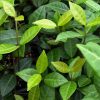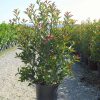Container Grown Fruit Trees
Variety selection is one of the most important steps when growing fruit trees in North Texas. Depending on the size of the planting site, you will need to decide how many trees you want to plant and what kind. It’s always a good idea to plant two of each cultivar, keeping in mind that not all fruit trees will perform the same from one year to the next. One tree may handle a late freeze where the other may not and vise versa. Some cultivars are self-fruitful, meaning no pollinator is needed to produce fruit. Other cultivars will require cross-pollination, or two different varieties for maximum fruit production. Cross-pollination occurs when a separate individual plant aids in the reproduction process of another plant. Most plants need help moving pollen from one plant to another; this is don with insects such as bees, butterflies and hummingbirds.
The production of fruit is dependent on the number of chilling hours we receive each year. Chilling hours refers to the number of hours at or below 45* accumulated from October 1st through February 28th. The average amount of chilling hours in North Texas is approximately 800-900 hours. This temperate process helps to maintain dormancy, ensuring the previous years buds will fully develop. Hours of less than 800-900 can cause the tree to break from dormancy causing early bud swell, making it more susceptible to late frost damage and possible loss of fruit production.
Fall is the perfect time to plant container grown fruit trees, although they can be planted year round planting them now will give them plenty of time to become established by spring.
Below we’ve listed a few well know varieties that do especially well in North Texas.
Apples- (malus pumila)
Red Delicious
America’s favorite red apple is tender, crisp, juicy, and has mild flavor for fresh eating. Fruit trees need a minimum of 6-8 hours sunlight daily and need water. They are not drought tolerant. (Pollinate with Yellow Delicious, Red Jonathan or Early Harvest) (Zones 5-8)
Yellow Delicious
Yellow Delicious is a large golden apple that ripens late with a fine, sweet flavor. Home use for eating, pies, and preserves. Fruit trees need a minimum of 6-8 hours sunlight daily, and need water. They are not drought tolerant. (Pollinate with Red Delicious, Red Jonathan or Early Harvest) (Zones 5-8)
Granny Smith
Granny Smith is a crisp, tart apple with deep green color with an occasional pink blush. Ripens early November. This variety is heat and drought tolerant. Fruit Trees needs 6-8 hours sunlight daily and need water. (Pollinate with Red Delicious or Yellow/Golden Delicious) (Zones 6-9)
Figs– (ficus carica)
Celeste
This variety produces high quality fruit. Bears on a small to medium sized tree. The fruit is violet to purple-brown in color with white flesh. High yielding and cold tolerant. The fruit is firm juicy and sweet. Plant Celeste where it gets some afternoon shade during the summer months. Ripens early July. (Zones 7-10)
Texas Everbearing
This variety has brownish-yellow bell shaped fruit with amber colored flesh. The shape of the tree is more upright instead of broad spreading. Cold tolerant. It bears well with delicious almost seedless fruit. With good growing conditions it can produce two crops a year. The early crop ripens in late May to late June and the second crop in late August. (Zones 7-10)
Peaches– (prunus persica)
Belle of Georgia
Belle of Georgia bears large fruit with brilliant red colored blooms. Belle of Georgia is very firm and highly flavorful white freestone flesh. Peach trees need a minimum of 6-8 hours sunlight daily, and need water. They are not drought tolerant. Requires 700-800 chilling hours. Self-pollinating. (Zones 5-9)
Florida King
The Florida King peach is a yellow clingstone peach that ripens in mid-May. It has a sweet and very flavorful flesh. Makes an excellent choice for baking and deserts. Peach trees need a minimum of 6-8 hours sunlight daily. Not cold tolerant. Requires 450 chilling hours. (Zones 7-9)
Elberta
The Elberta peach is the most popular and most commonly planted peach tree in North Texas. It is a very high quality canning and eating peach. Peach trees need a minimum of 6-8 hours of sunlight daily. With a small pit and very sweet flesh. Ripens mid-July. Requires 850 chilling hours. (Zones 5-9)
Sam Houston
The Sam Houston peach was developed by Texas A&M. The flowers are pink and fragrant; the fruit is yellow-fleshed, juicy and sweet. Peach trees need a minimum of 6-8 hours sunlight daily Sam Houston peaches are freestone and have a small pit. They are self-pollinating. Requires 500 chilling hours. (Zones 5-9)
Pears– (pyrus sp.)
Orient
Orient is named for it large round shaped fruit. It is similar to the Asian pears. Orient Pears have yellow skin with smooth, sweet firm, juicy white flesh. Orient is resistant to Fire Blight and is a heavy producer. Ripens in August. Orient performs best planted with a pollinator such as Kieffer or Moonglow. Requires 300 chilling hours. (Zones 5-9)
Kieffer
An Oriental pear tree used as an ornamental as well as a fruiting variety with large yellow fruit. The white flesh is crisp, juicy, with a coarse texture. It produces fruit in late September. Very hardy and tolerates hot climates. Kieffer is self-fertile, for best results plant two different varieties of trees to ensure cross-pollination. Requires 350 chilling hours. (Zones 4 – 9)
Ayers
This pear is small to medium in size with yellow and red blushed flavorful flesh that is grit free. Makes an excellent choice for canning and fresh eating. Ayer is one of the highest quality pears available for the home orchard. Ripens in mid August. Requires 350 chilling hours. (Zones 6-9)
Plums- (prunus salicina)
Santa Rosa
Santa Rosa is a Japanese variety with a large oval shaped fruit. It has a purple-red colored skin with small dots covering the entire surface. This variety has fragrant fine textured clingstone flesh. Partially self-fruitful tree that does best when planted with other varieties. Ripens mid-season. Requires 300 chilling hours. (Zones 5-9)
Methley
Methley plums have mid sized reddish-purple fruit. It has juicy flesh with a distinct flavor. This plum is good for fresh eating as well as for making jellies. An excellent upright tree that does well in most soils. Ripens late May to mid July. Requires 150-250 chilling hours. (Zones 5-9)
Ozark Premier
Ozark Premier is also a Japanese variety with bright red skin. It produces a juicy clingstone yellow flesh with a small pit. It ripens late summer and will produce several crops in one season. Requires 700-800 chilling hours. (Zones 5-9)
Morris
A reddish-black skinned, medium-large sized plum with red flesh. It ripens early, and its flesh is firm, somewhat dry, and crisp with good flavor. It is a large tree that requires 800 chilling hours and a pollinator.



